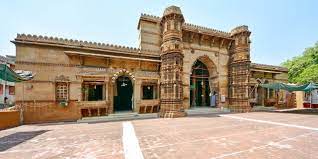
The mosque was built by Mahmud Begada probably in the years 1430-1440 of Ahmad Shah I's reign. It is named after Rani Rupamati whom Mahmud Begada married after the death of Qutubuddin. This mosque measures 105 feet long, forty-six broad, and thirty-two high. A high central arch, three imposing domes, slim minarets, carved galleries, and an exquisite mihrab are there. Its three domes are linked together by a flat roof. The side entrances in the mosque open out in balcony windows on either side and end in a lattice window. The central section is an elevated level that rises above the small flanks and provides a pierced clerestory, which carries the dome above. Though broken short in the 1819 Rann of Kutch earthquake, the bases of their minarets, from the delicate tracery in their niches, are still the mosque's chief beauty. Unfortunately, it is one of the buildings where the attempt to combine the arched Islamic and the flat Hindu styles was hardly a success; the plainness of the central arch clashes with the extreme richness of the upper cornice and the side minarets. Close by the mosque is a monument, with a large central and two side domes, raised over the tombs of Rani Rupamati and the other queen. The inside of the dome is richly fretted.